#serviceberry flowers
Photo
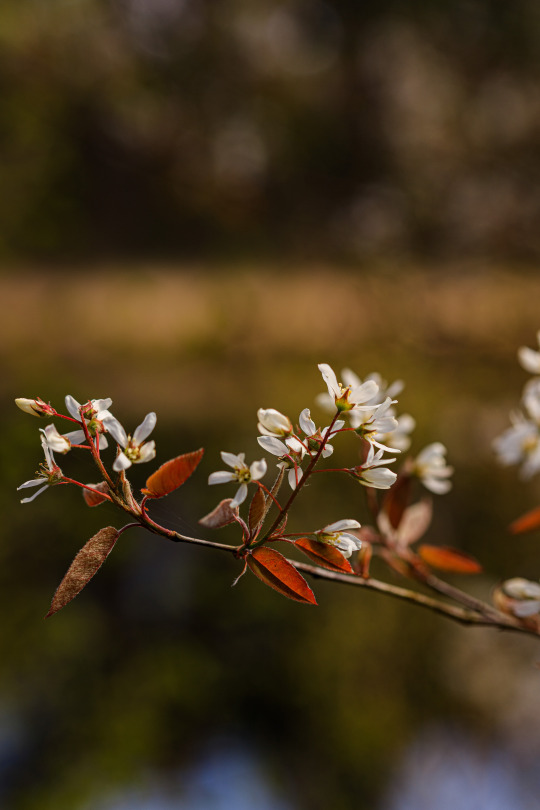
Serviceberry flowers 8/? - Brabantse Vennenpad, The Netherlands, April 2021
photo by: nature-hiking
#serviceberry#flowers#wildflowers#forest#landscape#serviceberry flowers#dutch landscape#nature#hiking#long distance trail#brabantse vennenpad#photography#photographers on tumblr#original photography#brabantse vennenpad 2021
97 notes
·
View notes
Photo

Blue Jay on Shadbush
#bird#blue jay#jay#shadbush#flowers#illustration#drawing#jada fitch#natural#Cyanocitta cristata#wildlife#illustation#art#design#pen and ink#serviceberry#Amelanchier canadensis#Canadian serviceberry#chuckle-berry#currant-tree#blue
530 notes
·
View notes
Text
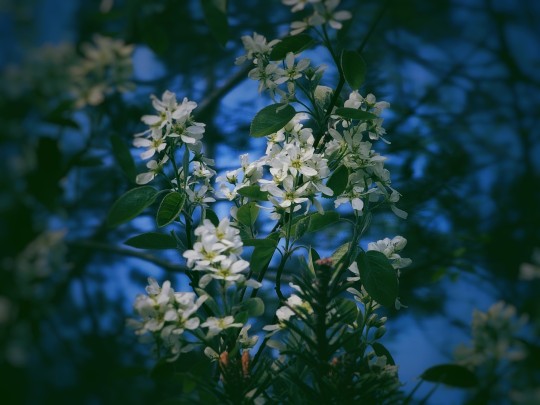

Amelanchier × spicata, the low juneberry
#Amelanchier × spicata#the low juneberry#thicket shadbush#dwarf serviceberry#low serviceberry#juneberry#photography#mine#nature#nature photography#original photographers#flower#white flowers#flowers#flower photography#blossoms#photographers of tumblr#photographers on tumblr
22 notes
·
View notes
Text
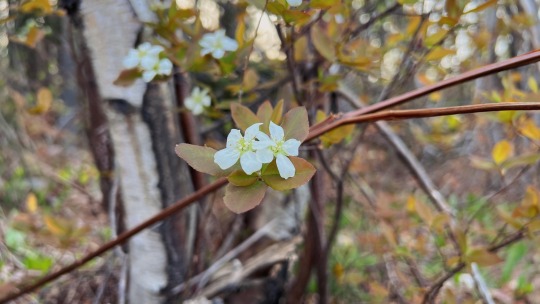
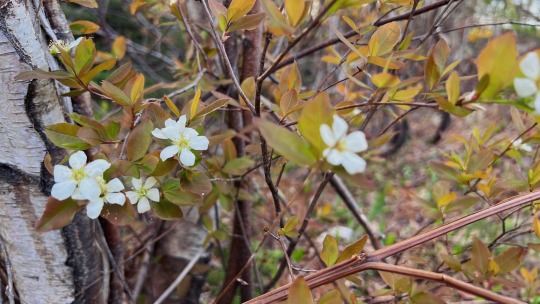
Serviceberry blooms. While working at the vegetable garden these past couple of weeks, I have been seeing so many insects and pollinators just buzzing around with no flowers to land on and it just broke my heart. So happy to see more and more flowers coming out
16-May-2023
32 notes
·
View notes
Photo

14 notes
·
View notes
Photo

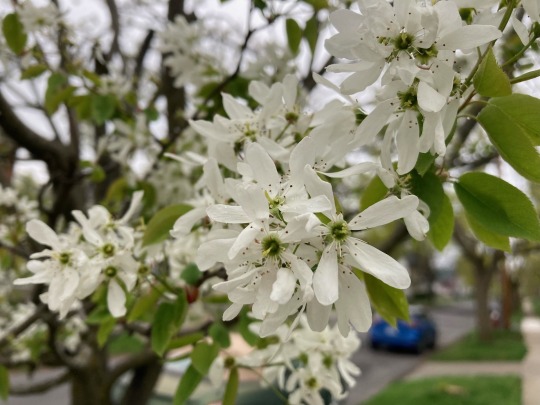
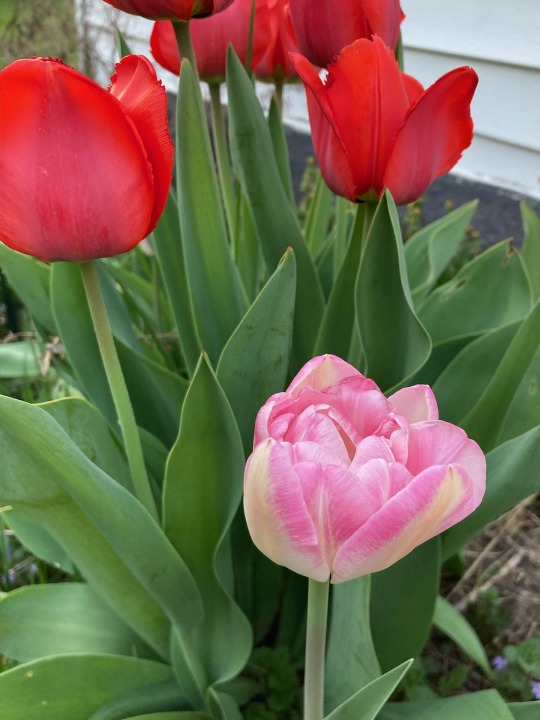
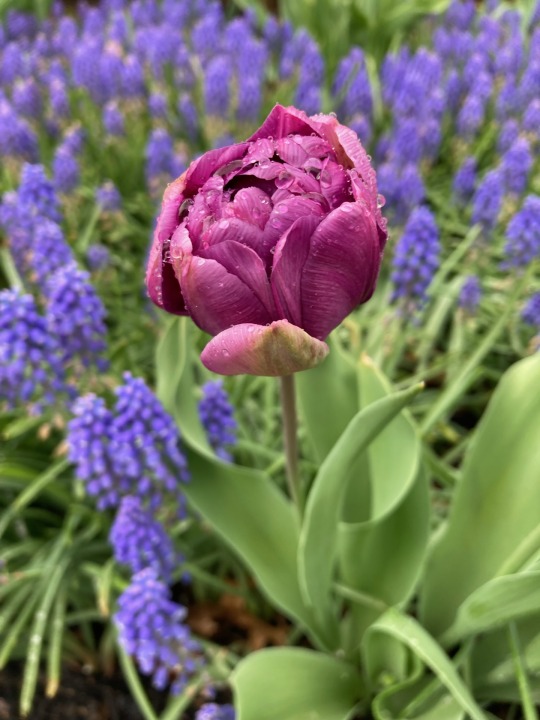


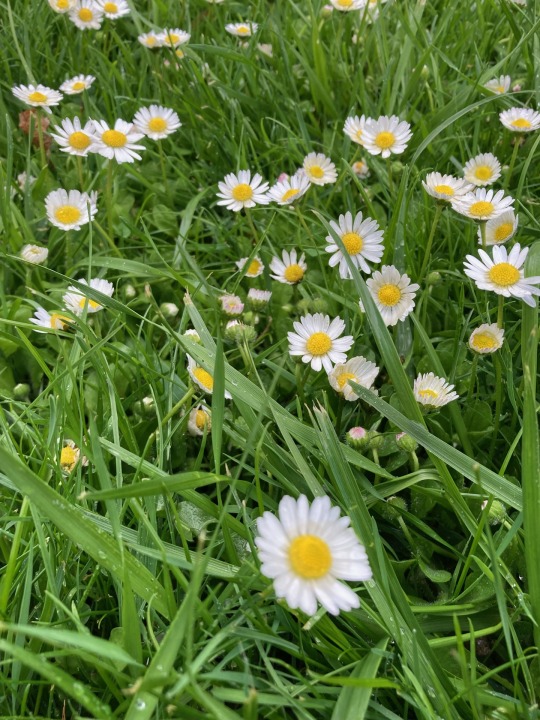

Assorted April flowers from my home (and a few cute daisies spotted in a neighbor’s lawn). Regrettably, I missed my chance to capture the earliest cherry blossoms and the violets that came in before the tulips. (I’m planning on putting in some muscari to fill out that bed with the hyacinths, which looks more like a sea of mulch than a flowerbed.)
Flowers identified in alternate text to the best of my ability.
#flowers#plant photography#botanical photography#gardening#tulips#hyacinths#muscari#grape hyacinths#daisies#daffodils#serviceberry#pretty flowers
15 notes
·
View notes
Text




photography by afton
2 notes
·
View notes
Text


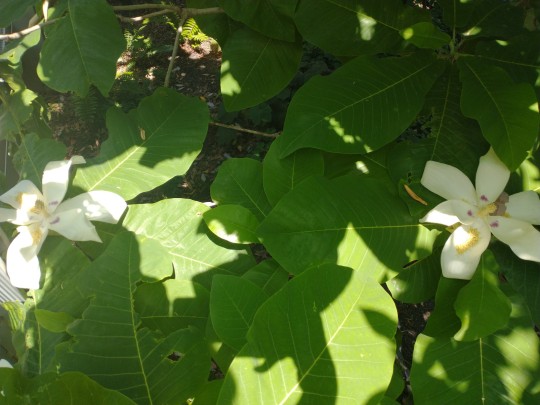


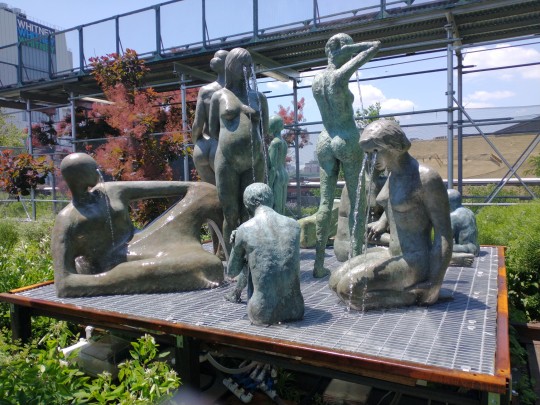


green and glass
w/ @miyamuratx <3
#nyc#manhattan#high line#high line park#new york#new york city#park#nyc parks#new york parks#magnolia#saskatoon serviceberries#i saw crows eating these berries and i was like hmm maybe i can also have these#skyscrapers#memorial day weekend#memorial day#05/30/2022#flowers#city#plants#plantblr#crying statue
3 notes
·
View notes
Text
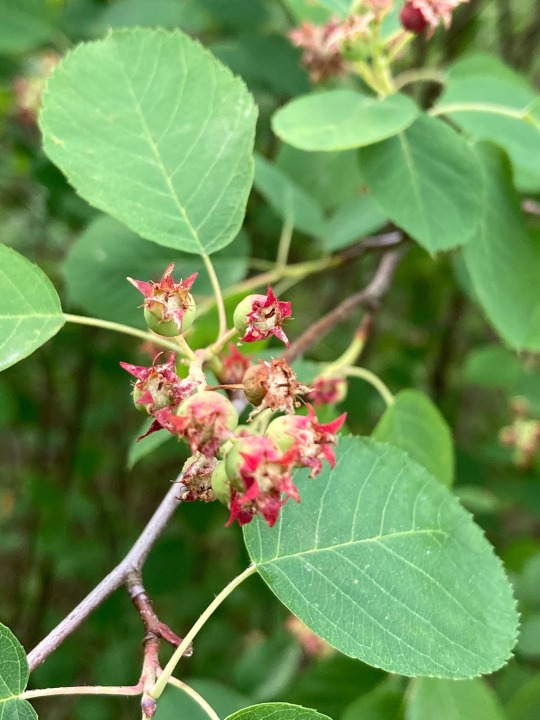
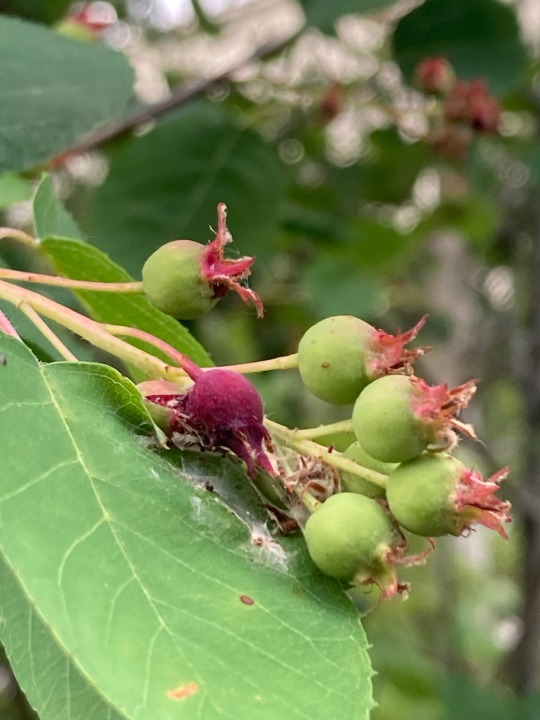

1 note
·
View note
Text
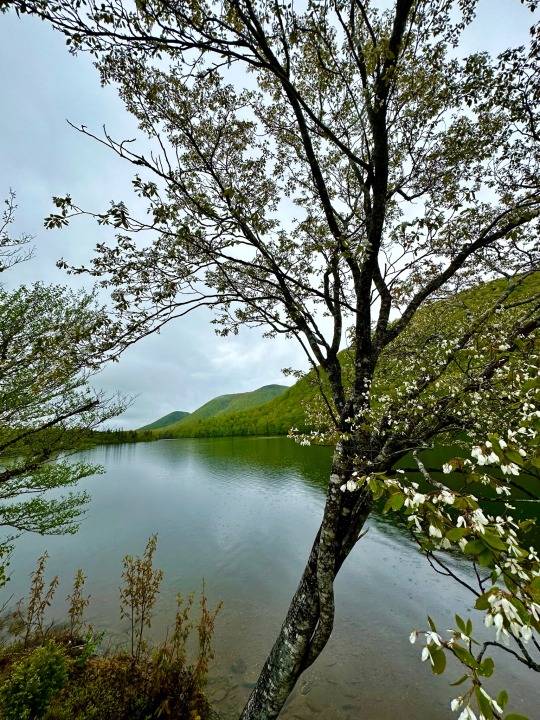
Beautiful spring on the lake. 2023-05-03
#lakeview#lakelife#lakescape#nature#nature photography#photography#nova scotia#water#cape breton#canada#spring#flowers#flowering trees#serviceberry#mountains#mountain#geology#rainyday#rainyvibes
0 notes
Text
Dreams in Blooms.
When I was in middle school, I had a dream where I was sitting in a patch of violets and clovers, making bracelets.
When I was in high school I had a dream where someone grew me a field of dandelions and we held hands.
Then in college I had a dream where someone showed me a field of bleeding hearts and we had a picnic under a tree.
A year or two after graduating, I had a dream where someone showed me a field of black eyed Susan's and we walked through it catching butterflies.
In my mid 20s, I dreamt someone growing a multi head sunflower and we talked and shared some chocolate.
A few years ago when my life was difficult, I dreamt about a forest floor of ferns and moss and someone pointing out a tiny patch of lady slipper orchids and a bird in a blooming dogwood tree.
Won't you come meet me under the service berry tree where the cedar waxwings sing?
#dreams#flowers#violets#clover#dandelion#bleeding heart#black eye susan#sunflower#moss#fern#lady slipper orchid#orchid#dogwood#serviceberry#cedar waxwing
1 note
·
View note
Video
n380_w1150 by Biodiversity Heritage Library
Via Flickr:
A guide to the wild flowers.. New York,F. A. Stokes[1899]. biodiversitylibrary.org/page/40764791
#United States#Wild flowers#New York Botanical Garden#LuEsther T. Mertz Library#bhl:page=40764791#dc:identifier=https://biodiversitylibrary.org/page/40764791#artist:name=Marian Ellis Rowan#Merian Ellis Rowan#HerNaturalHistory#Taxonomy:binomial=Amelanchier canadensis#Taxonomy:common=Canadian serviceberry#Taxonomy:family=Rosaceae#Taxonomy:common=Shad-bush#Serviceberry#WomenInScience#flickr#amelanchier canadensis#bilberry#canadian serviceberry#chuckle-berry#currant-tree#juneberry#shad-blow serviceberry#shad-blow#shadbush#shadbush serviceberry#sugarplum#thicket serviceberry
0 notes
Text
There, in the sunlit forest on a high ridgeline, was a tree I had never seen before.
I spend a lot of time looking at trees. I know my beech, sourwood, tulip poplar, sassafras and shagbark hickory. Appalachian forests have such a diverse tree community that for those who grew up in or around the ancient mountains, forests in other places feel curiously simple and flat.
Oaks: red, white, black, bur, scarlet, post, overcup, pin, chestnut, willow, chinkapin, and likely a few others I forgot. Shellbark, shagbark and pignut hickories. Sweetgum, serviceberry, hackberry, sycamore, holly, black walnut, white walnut, persimmon, Eastern redcedar, sugar maple, red maple, silver maple, striped maple, boxelder maple, black locust, stewartia, silverbell, Kentucky yellowwood, blackgum, black cherry, cucumber magnolia, umbrella magnolia, big-leaf magnolia, white pine, scrub pine, Eastern hemlock, redbud, flowering dogwood, yellow buckeye, white ash, witch hazel, pawpaw, linden, hornbeam, and I could continue, but y'all would never get free!
And yet, this tree is different.
We gather around the tree as though surrounding the feet of a prophet. Among the couple dozen of us, only a few are much younger than forty. Even one of the younger men, who smiles approvingly and compliments my sharp eye when I identify herbs along the trail, has gray streaking his beard. One older gentleman scales the steep ridge slowly, relying on a cane for support.
The older folks talk to us young folks with enthusiasm. They brighten when we can call plants and trees by name and list their virtues and importance. "You're right! That's Smilax." "Good eye!" "Do you know what this is?—Yes, Eupatorium, that's a pollinator's paradise." "Are you planning to study botany?"
The tree we have come to see is not like the tall and pillar-like oaks that surround us. It is still young, barely the diameter of a fence post. Its bark is gray and forms broad stripes like rivulets of water down smooth rock. Its smooth leaves are long, with thin pointed teeth along their edges. Some of the group carefully examine the bark down to the ground, but the tree is healthy and flourishing, for now.
This tree is among the last of its kind.
The wood of the American Chestnut was once used to craft both cradles and coffins, and thus it was known as the "cradle-to-grave tree." The tree that would hold you in entering this world and in leaving it would also sustain your body throughout your life: each tree produced a hundred pounds of edible nuts every winter, feeding humans and all the other creatures of the mountains. In the Appalachian Mountains, massive chestnut trees formed a third of the overstory of the forest, sometimes growing larger than six feet in diameter.
They are a keystone species, and this is my first time seeing one alive in the wild.
It's a sad story. But I have to tell you so you will understand.
At the turn of the 20th century, the chestnut trees of Appalachia were fundamental to life in this ecosystem, but something sinister had taken hold, accidentally imported from Asia. Cryphonectria parasitica is a pathogenic fungus that infects chestnut trees. It co-evolved with the Chinese chestnut, and therefore the Chinese chestnut is not bothered much by the fungus.
The American chestnut, unlike its Chinese sister, had no resistance whatsoever.
They showed us slides with photos of trees infected with the chestnut blight earlier. It looks like sickly orange insulation foam oozing through the bark of the trees. It looks like that orange powder that comes in boxes of Kraft mac and cheese. It looks wrong. It means death.
The chestnut plague was one of the worst ecological disasters ever to occur in this place—which is saying something. And almost no one is alive who remembers it. By the end of the 1940's, by the time my grandparents were born, approximately three to four billion American chestnut trees were dead.
The Queen of the Forest was functionally extinct. With her, at least seven moth species dependent on her as a host plant were lost forever, and no one knows how much else. She is a keystone species, and when the keystone that holds a structure in place is removed, everything falls.
Appalachia is still falling.
Now, in some places, mostly-dead trees tried to put up new sprouts. It was only a matter of time for those lingering sprouts of life.
But life, however weak, means hope.
I learned that once in a rare while, one of the surviving sprouts got lucky enough to successfully flower and produce a chestnut. And from that seed, a new tree could be grown. People searched for the still-living sprouts and gathered what few chestnuts could be produced, and began growing and breeding the trees.
Some people tried hybridizing American and Chinese chestnuts and then crossing the hybrids to produce purer American strains that might have some resistance to the disease. They did this for decades.
And yet, it wasn't enough. The hybrid trees were stronger, but not strong enough.
Extinction is inevitable. It's natural. There have been at least five mass extinctions in Earth's history, and the sixth is coming fast. Many people accepted that the American chestnut was gone forever. There had been an intensive breeding program, summoning all the natural forces of evolution to produce a tree that could survive the plague, and it wasn't enough.
This has happened to more species than can possibly be counted or mourned. And every species is forced to accept this reality.
Except one.
We are a difficult motherfucker of a species, aren't we? If every letter of the genome's book of life spelled doom for the Queen of the Forest, then we would write a new ending ourselves. Research teams worked to extract a gene from wheat and implant it in the American chestnut, in hopes of creating an American chestnut tree that could survive.
This project led to the Darling 58, the world's first genetically modified organism to be created for the purpose of release into the wild.
The Darling 58 chestnut is not immune, the presenters warned us. It does become infected with the blight. And some trees die. But some live.
And life means hope.
In isolated areas, some surviving American Chestnut trees have been discovered, most of them still very young. The researchers hope it is possible that some of these trees may have been spared not because of pure luck, but because they carry something in their genes that slows the blight in doing its deadly work, and that possibly this small bit of innate resistance can be shaped and combined with other efforts to create a tree that can live to grow old.
This long, desperate, multi-decade quest is what has brought us here. The tree before me is one such tree: a rare survivor. In this clearing, a number of other baby chestnut trees have been planted by human hands. They are hybrids of the Darling 58 and the best of the best Chinese/American hybrids. The little trees are as prepared for the blight as we can possibly make them at this time. It is still very possible that I will watch them die. Almost certainly, I will watch this tree die, the one that shades us with her young, stately limbs.
Some of the people standing around me are in their 70's or 80's, and yet, they have no memory of a world where the Queen of the Forest was at her full majesty. The oldest remember the haunting shapes of the colossal dead trees looming as if in silent judgment.
I am shaken by this realization. They will not live to see the baby trees grow old. The people who began the effort to save the American chestnut devoted decades of their lives to these little trees, knowing all the while they likely never would see them grow tall. Knowing they would not see the work finished. Knowing they wouldn't be able to be there to finish it. Knowing they wouldn't be certain if it could be finished.
When the work began, the technology to complete it did not exist. In the first decades after the great old trees were dead, genetic engineering was a fantasy.
But those that came before me had to imagine that there was some hope of a future. Hope set the foundation. Now that little spark of hope is a fragile flame, and the torch is being passed to the next generation.
When a keystone is removed, everything suffers. What happens when a keystone is put back into place? The caretakers of the American chestnut hope that when the Queen is restored, all of Appalachia will become more resilient and able to adapt to climate change.
Not only that, but this experiment in changing the course of evolution is teaching us lessons and skills that may be able to help us save other species.
It's just one tree—but it's never just one tree. It's a bear successfully raising cubs, chestnut bread being served at a Cherokee festival, carbon being removed from the atmosphere and returned to the Earth, a wealth of nectar being produced for pollinators, scientific insights into how to save a species from a deadly pathogen, a baby cradle being shaped in the skilled hands of an Appalachian crafter. It's everything.
Despair is individual; hope is an ecosystem. Despair is a wall that shuts out everything; hope is seeing through a crack in that wall and catching a glimpse of a single tree, and devoting your life to chiseling through the wall towards that tree, even if you know you will never reach it yourself.
An old man points to a shaft of light through the darkness we are both in, toward a crack in the wall. "Do you see it too?" he says. I look, and on the other side I see a young forest full of sunlight, with limber, pole-size chestnut trees growing toward the canopy among the old oaks and hickories. The chestnut trees are in bloom with fuzzy spikes of creamy white, and bumblebees heavy with pollen move among them. I tell the man what I see, and he smiles.
"When I was your age, that crack was so narrow, all I could see was a single little sapling on the forest floor," he says. "I've been chipping away at it all my life. Maybe your generation will be the one to finally reach the other side."
Hope is a great work that takes a lifetime. It is the hardest thing we are asked to do, and the most essential.
I am trying to show you a glimpse of the other side. Do you see it too?
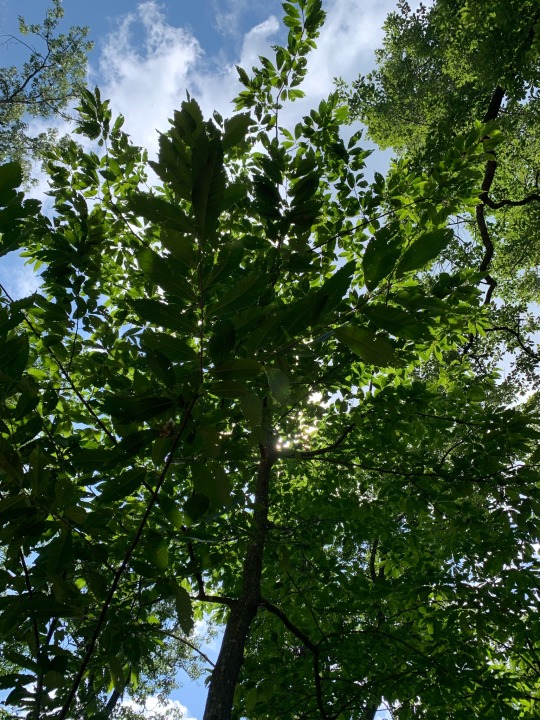
#american chestnut#hope#climate change#biodiversity crisis#climate crisis#trees#plantarchy#learning to imagine the future
3K notes
·
View notes
Text

Headline by: Ryan Burns. “Ground Has Been Broken on Klamath River Restoration, the World’s Largest-Ever Dam-Removal Project.” Lost Coast Outpost. 23 March 2023.
---

The world’s largest dam removal in history is slated for 2023. Led by Indigenous tribes in partnership with organizations, lawyers, scientists and activists, the project will remove four dams, clearing the way for the lower Klamath River to flow freely for the first time in more than a century.
Headline and italicized text excerpt by: Malia Russ. “The Science of Saving Salmon as Klamath Dams Come Down.” UC Davis - Blogs - Climate. 24 February 2023.
---

Headline by: Jackson Guilfoil. “Klamath dam removals, habitat restoration, begins.” The Mercury News. 25 March 2023.
---
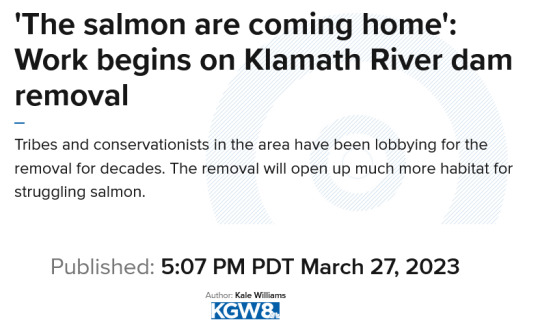
Headline by: Kale Williams. “‘The salmon are coming home’: Work begins on Klamath River dam removal.” KGW8. 27 March 2023.
---

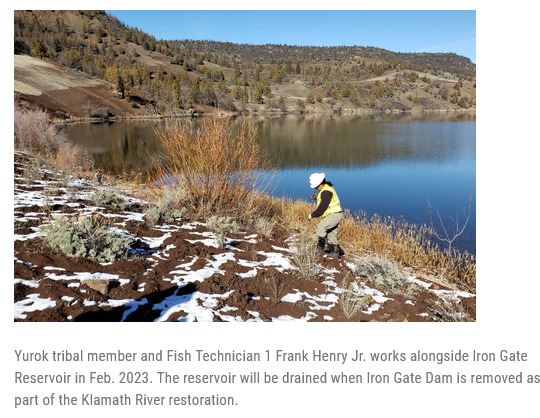

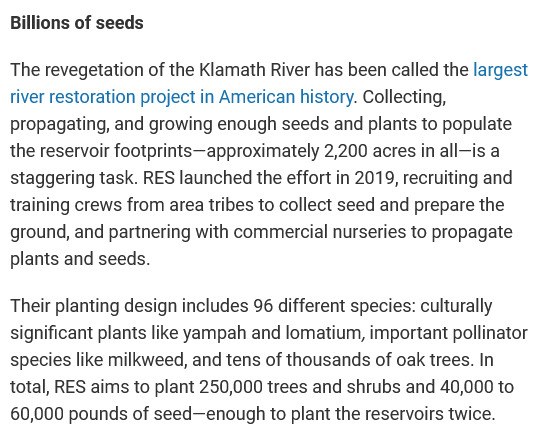
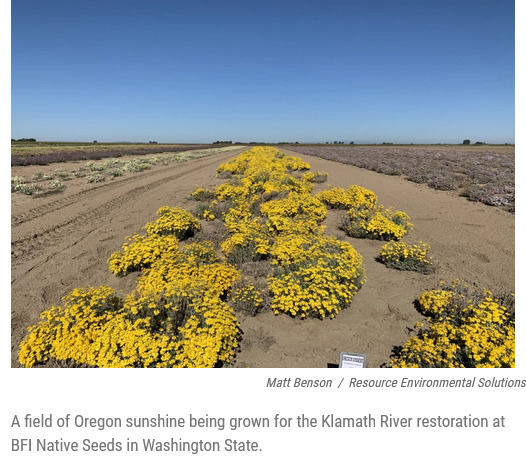
Iron Gate is a sinuous, skinny reservoir tucked into the folds of the Siskiyou Mountains. Draining it will expose about 900 acres of wet mud. “It’s our job to make sure it’s revegetated. We want that to be revegetated with a healthy native plant ecosystem,” says Joshua Chenoweth, Senior Riparian Ecologist for the Yurok Tribe who is leading the replanting effort. [...] Last fall, they seeded the strip with a mix of native grasses and flowering plants; now, they’re installing young shrubs and trees: buckbrush, serviceberry, and Oregon ash, along with the Klamath plum. Collectively, these plants will create a “wall of green,” taking up space that would have otherwise been overrun by non-native plants [...]. The revegetation of the Klamath River has been called the largest river restoration project in American history. Collecting, propagating, and growing enough seeds and plants to populate the reservoir footprints -- approximately 2,200 acres in all -- is a staggering task. [...] Their planting design includes 96 different species: culturally significant plants like yampah and lomatium, important pollinator species like milkweed, and tens of thousands of oak trees. [...] What will a restored, wild Klamath River look like? Imagine it. Stand at the Wanaka Springs boat launch and picture Iron Gate reservoir drained. The river has found its channel at the base of its original canyon. Willows flank the banks. Much of the reservoir footprint is flush with upland vegetation -- oak copses; thickets of buckbrush and Klamath plum; blooming rose and lupine.
---
Headline, images, captions, screenshot, and italicized text excerpt from: Juliet Grable. “After the dams: Restoring the Klamath River will take billions of native seeds.” Jefferson Public Radio. 13 March 2023.
2K notes
·
View notes
Text
What Kind of Plants to Add
This is my sixth post in a series I’ll be making on how to increase biodiversity on a budget! I’m not an expert–just an enthusiast–but I hope something you find here helps!
I’d love to be able to give a quick and easy list of things to add, but frankly I can’t do that. I can strongly encourage you, however, to look at these categories of plants and do further research to discover what’s native to your area, so you can plant things that’ll have the most impact in your particular area.
With that being said, I will mention a few plants as examples. This is in no way, shape, or form me telling you that you have to or even should buy these specific plants. Not every plant works well in every place in every garden, not to even mention across countries. Above all, if you’re wondering what plants you should be adding, I can wholeheartedly say plants that are native to your area--or at least nonnative non-invasive.
Flowers
Flowers are some of the most common ways people work to increase biodiversity in their gardens, and who can blame them? Seeing pops of color out your window, and directly seeing the impact via butterflies and bees visiting the garden? It’s a win-win for us and the wildlife!
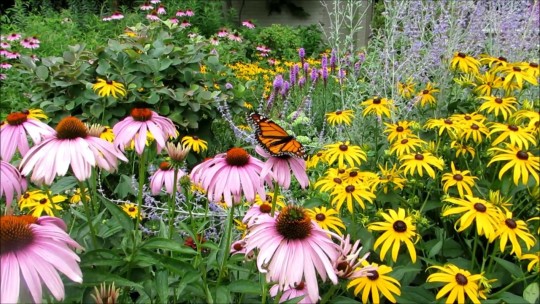
Flowers--especially native wildflowers--are a quick, easy, and cheap way to increase wildlife traffic in your garden. Perennial gardens are more likely to get you the most bang for your buck, as they’ll come back year after year if you treat them well. But don’t dismiss annuals--if you get ones that easily reseed, they’ll eagerly return on their own! If you can, do your best to ensure that the flowers you plant all have different blooming periods--that way, your garden can support wildlife throughout the year instead of for just one brief season.
Flowers are environmental super boosters. Their nectar and pollen can feed insects and birds, their stems and leaves can provide nesting materials for all sorts of creatures, and their seeds are a popular food source among birds at all times of the year.
Climbing Plants
Climbing plants can be fantastic options for maximizing your impact. If you have limited ground space, growing up can provide interest as well as additional habitat for all kinds of creatures.

Training plants up a trellis, fence, or bare wall offers food, shelter, and habitat. Trumpet vines, passionflowers, honeysuckles, and more will provide sweet nectar for pollinators as well as nesting and hiding spaces for other wildlife like birds, bugs, and lizards. Do note that in some cases, climbing plants can actually affect the structural integrity of walls and roofs if allowed to climb too much and too far along a house, so be careful.
Bushes/Shrubs
Bushes provide shelter for creatures, which then provides hunting grounds for other animals. Their fallen leaves and petals can be food and shelter for detritivores, amphibians, reptiles, and small mammals--and they also provide good cover for moving around the garden, for creatures who like to stay hidden. They can be a bit more pricey to obtain--unless you get cuttings or seeds and are willing to wait--but they’ll definitely be worth it, and they’re typically low-maintenance once they’re established.
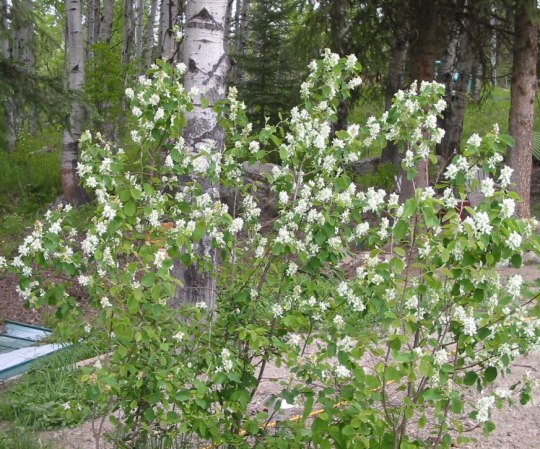
Bonus points if you get a flowering and fruiting bush, like bottlebrush, serviceberry, lilac, or others. This’ll make your bushes not only a place of shelter, but a food source as well--and depending on the kind you pick, may be food for you too! Making a garden border with a series of bushes can be a great option to providing lots of habitat, if you can manage it.
Shrubs with pithy or hollow stems are excellent options for supporting solitary bees. Some examples you could look into are elderberry, raspberry, blackberry, or sumac.
Trees
Trees have a high up-front cost and take awhile to grow, but once they’re settled in place they provide crucial habitat to all kinds of creatures! Insects will be attracted to flowers they may provide, or to nest in the wood. Others may eat the leaves as food, or use them as nesting materials. Birds will perch and nest in trees, and feed off the fruits and seeds and insects that also use the tree. Squirrels also use trees as nesting places, piling up dead leaves into huge clusters to raise their young in, and will absolutely feast on any nuts the tree may provide. Mice, badgers, and more will feast on fallen fruits or seeds, and bats roost in the trunks when given the chance. Detritivores eat fallen leaves and decomposing fruits, providing further food for hunting creatures. Trees can also be good for us--they help block out noise and air pollution, and are the poster child for taking CO2 and making it breathable oxygen. Not to mention they can provide plenty of food for us, too. Nesting grounds, hunting grounds, shelter from weather, and more--trees are, in my opinion, likely to be the best way to boost biodiversity long-term. If you can get your hands on a sapling for cheap and can care for it for awhile, I’d definitely give it a shot! Make sure the tree won’t get too big for where you’re growing it, though--you’ve definitely gotta plan for the long-term before you plant any.
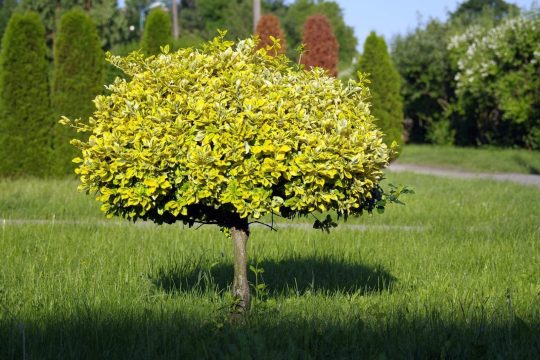
Some trees can be grown in containers. Though they won’t become gigantic branching behemoths, they’ll still do their part to support all the life that depends on them. Growing a tree from seed may take awhile, but could be an easy option to getting one if you have the patience--the trees are more than happy to help you, as they drop tons of seeds and fruit in fall for you to gather.
Groundcover
Bare soil is the enemy of microbial life in the soil, and while small pockets of bare soil can be great nesting places for bees and other insects, having swaths of empty soil should be avoided. Groundcover plants grow low to the ground in a sprawling habit, and will often spread quite easily on their own. This is a great way to provide shelter, keep soil temperatures cool, block out weeds, and give your soil life a chance to thrive.

Sometimes, ground covers don’t even have to be planted in the ground. Shallow-rooted plants like succulents, ferns, and alyssum can be planted into cracks in stone walls, and moss can be planted by making moss graffiti and painting it onto a surface. As with climbing plants, do make sure that you don’t cause extra damage to important walls and housing foundations.
Host Plants
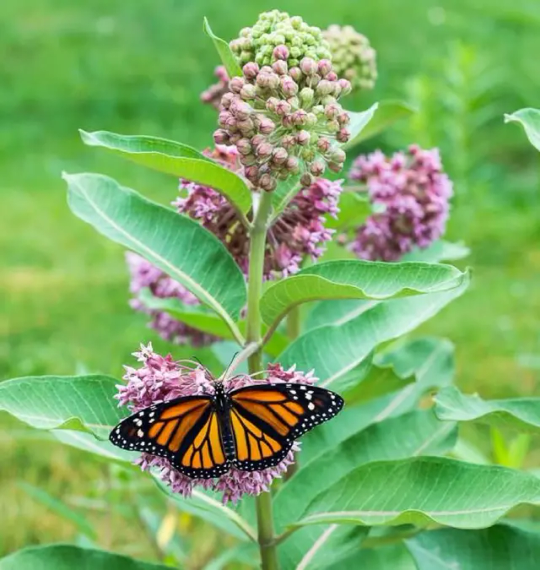
Host plants get their own section, because plants of all kinds can be host plants for different creatures! It’s common to think only flowers can be host plants in the beginning, but in reality, many bushes and trees are host plants to dozens of species of butterflies and moths. Honestly, I feel that factor's not talked about enough. Look up what insects live in your area and what kind of host plants they need, and plant some if you can! Bonus points if you can plant a variety of them--I know that there’s hundreds of kinds of milkweed, each one flowering and leafing up around different times of the year. Planting several varieties of milkweed, then, would provide monarchs with food through several seasons, allowing many more of them to grow up in your garden!
Nectar Plants
Plants that provide nectar to insects is a great foundation to increasing biodiversity! This is, of course, many native wildflowers (and even nonnative wildflowers, though be sure they aren’t invasives who’ll do more harm than good), but many native bushes, vines, and trees will also provide nectar to hungry pollinators!
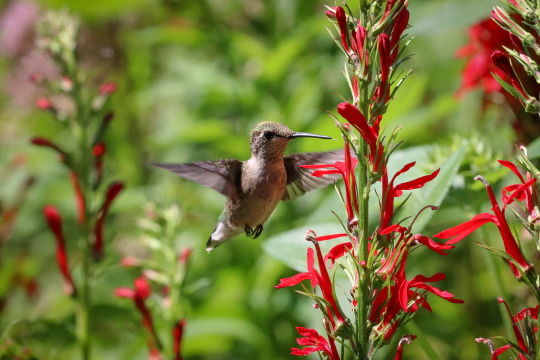
Keystone Species
To be frank, some plants can have a bigger impact than others in a landscape. By all means, every bit helps, but if you want to boost biodiversity quickly there are a few plants that can essentially serve as the backbone of local ecosystems that you can grow in anything from a balcony pot to a small patch of your backyard. These plants can be different depending on where you are, so do your research to find out what would be best to grow in your area. If you can’t get them all? That’s alright! But even hitting just a few of these target species really can do a lot.
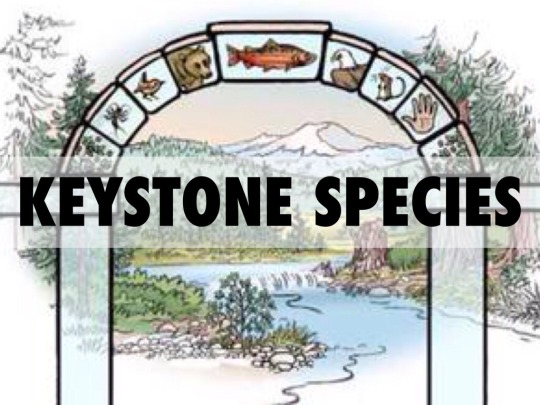
That’s the end of this post! My next post is gonna be about things to keep in mind/continue to do once you get plants in the ground! Until then, I hope this advice was helpful! Feel free to reply with any questions, your success stories, or anything you think I may have forgotten to add in!
#biodiversity#solarpunk#gardening#outdoor gardening#ani rambles#out of queue#the biodiversity saga#sorry its been 2 months since I last posted to this series#I literally have everything drafted out I just got Busy because maannnnnnn animating a grad school capstone project all by yourself....#i should really start using my youtube channel to post my animations but they never feel Done so I just Dont#i dont have as many links in this one because... they weren't in the draft and any tumblr posts that came to mind I couldn't hunt down#either way i hope this was Helpful and Lit and All That Jazz#I might just post the other parts tomorrow so I can stop having that hanging over my head#and so I can get my sources masterpost out there so people can like. see I'm trying my best not to just talk out of my ass#anyways see yall
158 notes
·
View notes
Text
I cannot believe I’m arguing with the most idiotic ecofascist bullshit today:
Me: Serviceberries are delicious! Plant more of them! Eat them!
Some white lady on Facebook: ~what about the birds??? What will THEY eat??????~
….
Listen, the myth that the Americas were some ~untouched wilderness~ is not just bullshit it is DESTRUCTIVE bullshit. In 1491, the Americas were a garden. These food forests were actively cultivated, just bc they look different than European agriculture does not in anyway make them less valid. Like, ok Yes, if you live in some suburban hellscape that’s been turned into HOA-enforced lawns, SURE, leave the berries for the birds. But to demand that be the rule for everyone, everywhere?? Fuck that. Last year the serviceberry crop was so bountiful they literally rotted in clusters like grapes on the vine. ~what about the birds~ THE BIRDS WERE DRUNK ON THE GROUND, KAREN! FAT AND ROUND! My woods turn white in the spring bc there are so many serviceberry trees. Right now the hazelnuts are flowering their little peener catkins as far as the eye can see, and because nothing has leafed out yet, THATS FAR!
Kill your lawn. Plant berries and fruit trees. EAT THEM!

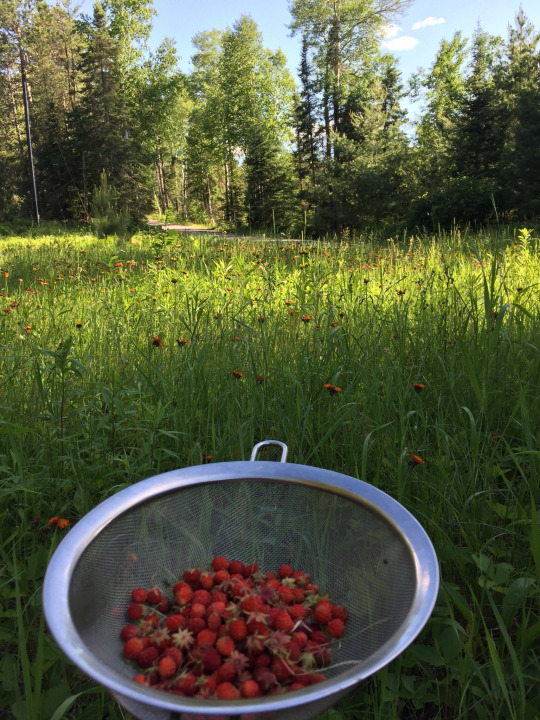
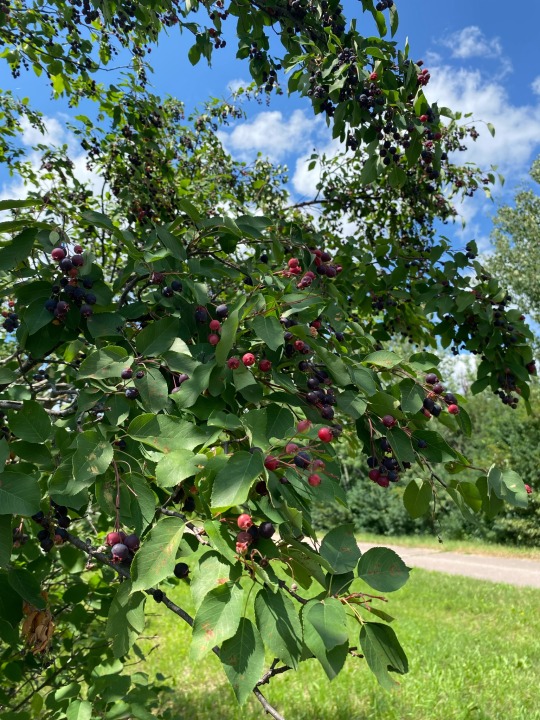
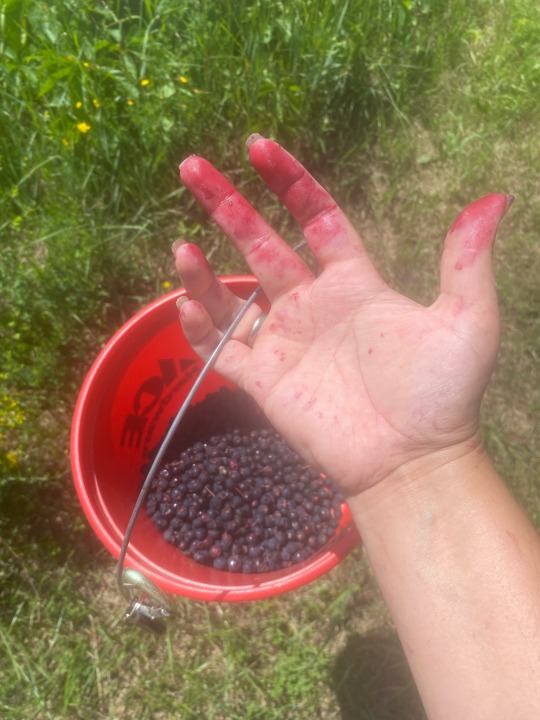

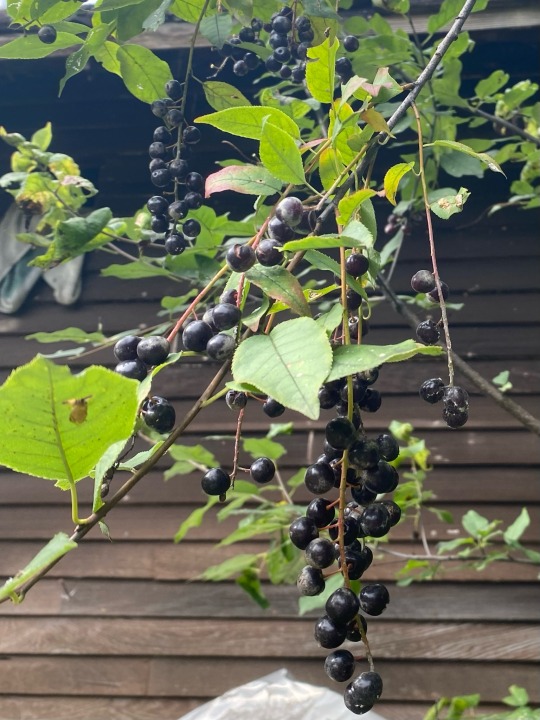
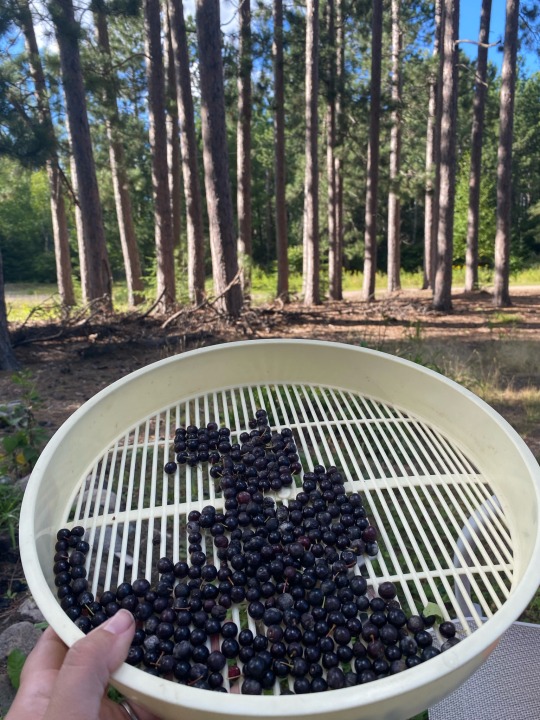
#rant#in the blessed words of Olly Costello: we have been given all the gifts#meanwhile in minnesota#foraging#kill your lawn#there has never been an ‘untouched wilderness’ here and to insist on enforcing that causes SIGNIFICANT HARM!
39 notes
·
View notes